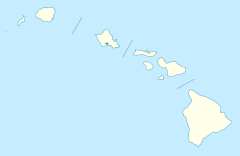Pearl City, Hawaii facts for kids
Quick facts for kids
Pearl City, Hawaii
|
|
|---|---|

Pearl City
|
|

Location in Honolulu County and the state of Hawaii
|
|
| Country | |
| State | |
| County | Honolulu |
| Area | |
| • Total | 10.06 sq mi (26.05 km2) |
| • Land | 9.12 sq mi (23.62 km2) |
| • Water | 0.94 sq mi (2.42 km2) |
| Elevation | 89 ft (27 m) |
| Population
(2020)
|
|
| • Total | 45,295 |
| • Density | 4,966.56/sq mi (1,917.62/km2) |
| Time zone | UTC−10:00 (Hawaii-Aleutian) |
| ZIP Code |
96782
|
| Area code(s) | 808 |
| FIPS code | 15-62600 |
| GNIS feature ID | 0363226 |
Pearl City is a community in Hawaii that isn't officially a city, but it's like one! It's located in the City & County of Honolulu on the island of Oʻahu. In 2010, about 47,698 people lived there. Pearl City is right along the northern edge of Pearl Harbor. To its east is Waimalu, and to its west is Waipahu. The postal code for Pearl City is 96782.
Contents
History of Pearl City
In the early days, Pearl City was covered with rice paddies. Farmers used water buffalo to plow the fields. In the 1880s, Pearl City became the last stop for the Oahu Railway, which was started by Benjamin Franklin Dillingham.
Land for the future "Pearl City" went on sale in 1889, right after the railway line was finished. In the early 1900s, a place called the Remond Grove was popular. People went there to enjoy music from pianos, banjos, trumpets, and saxophones.
Geography and Climate
Pearl City is located at 21°24'30" North and 157°58'1" West.
The area covers about 5.8 square miles (15 square kilometers). Most of this is land (5.0 square miles or 13 square kilometers), and a smaller part is water (0.8 square miles or 2.1 square kilometers).
Weather in Pearl City
Pearl City has warm weather all year round.
- In winter (around January), the average high temperature is about 79 degrees Fahrenheit (26 degrees Celsius).
- The average winter low is about 66 degrees Fahrenheit (19 degrees Celsius).
- In summer (around August), the average high temperature is about 87 degrees Fahrenheit (31 degrees Celsius).
- The average summer low is about 74 degrees Fahrenheit (23 degrees Celsius).
- Pearl City gets about 64 inches (163 centimeters) of rain each year.
Population and People
| Historical population | |||
|---|---|---|---|
| Census | Pop. | %± | |
| 1970 | 19,552 | — | |
| 1980 | 42,575 | 117.8% | |
| 1990 | 30,993 | −27.2% | |
| 2000 | 30,976 | −0.1% | |
| 2010 | 47,698 | 54.0% | |
| 2020 | 45,295 | −5.0% | |
| U.S. Decennial Census 1790–1960 1900–1990 1990–2000 2010–2015 |
|||
In 2010, Pearl City had 47,698 people living there. There were 14,622 households, which are groups of people living in the same home.
Many different groups of people live in Pearl City:
- About 60% of the people were of Asian-Pacific Islander background.
- About 17% were White.
- About 3% were African American.
- About 7% of the population were Hispanic or Latino.
- The rest were from other backgrounds or a mix of two or more.
About 18.8% of the people were under 18 years old. The average age was 37 years.
Education in Pearl City
Pearl City has many schools for students of all ages. The Hawai'i Department of Education runs the public schools here.
Public Schools
- Elementary Schools: Manana, Momilani, Palisades, Pearl City, Pearl City Highlands, Waimalu, and Waiau.
- Secondary Schools: Highlands Intermediate School and Pearl City High School.
Some of these schools, like Momilani and Pearl City High, were in a different area called Waimalu in 2000, but by 2010, they became part of the Pearl City area.
Other Schools and Libraries
- The Roman Catholic Diocese of Honolulu operates Our Lady of Good Counsel School, a private school that opened in 1964.
- The University of Hawaii–Leeward Community College is a college near Pearl City.
- The Hawaii State Public Library System runs the Pearl City Library, which opened in 1969.
Sports and Recreation
Pearl City is known for its strong youth sports teams, especially baseball!
- In 1998, the Pearl City Little League baseball team represented the U.S. in the Little League World Series finals, but they lost to a team from Taipei.
- In 2007, the Pearl City Junior League team won the Junior League World Series. They won against teams from across the U.S. and then beat the team from the Philippines in the finals.
- In 2017, another Pearl City youth baseball team, the Pearl City KRU, played in the Cal Ripken Baseball 10U World Series in Indiana. They did very well, winning all their games in the first round, but lost in the finals to a team from North Carolina.
- The Hawaii Hawks won the 2003 Field Hockey World Cup.
Famous People from Pearl City
Many notable people have connections to Pearl City:
- Brook Lee: She was Miss Hawaii USA in 1997, then became Miss USA 1997 and Miss Universe 1997.
- Jason Scott Lee: A well-known film actor.
- Duke Aiona: He was the lieutenant governor of Hawaii and was born in Pearl City.
- David Ige: He was the governor of Hawaii and was also born in Pearl City.
- Jordan Ta'amu: A professional football player.
- Verena Mei: A model and rally car driver.
See also
 In Spanish: Pearl City (Hawái) para niños
In Spanish: Pearl City (Hawái) para niños


